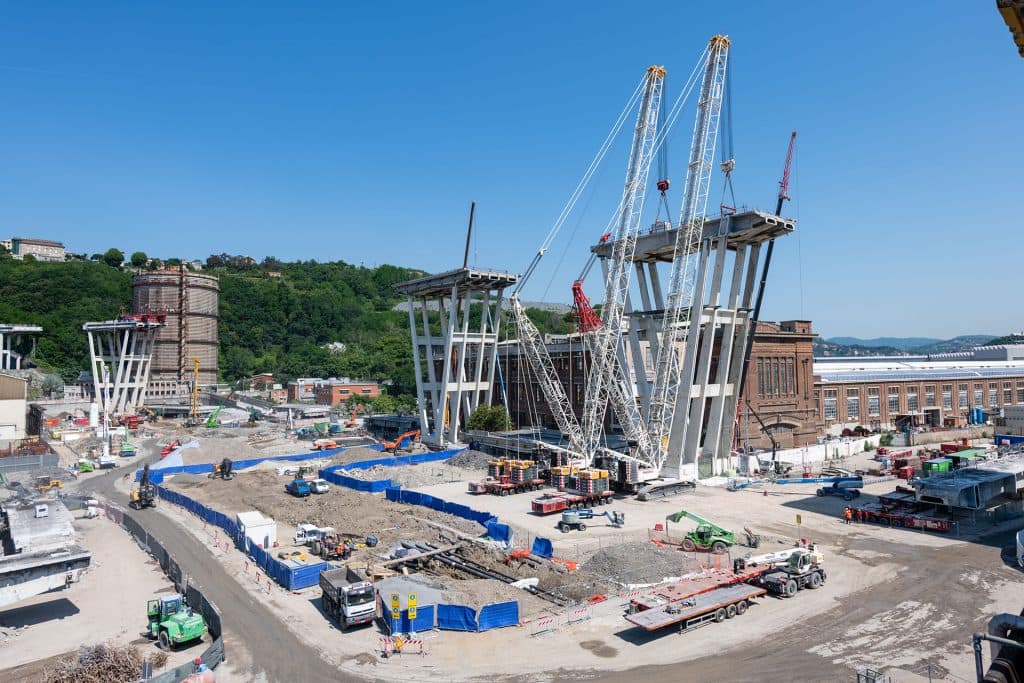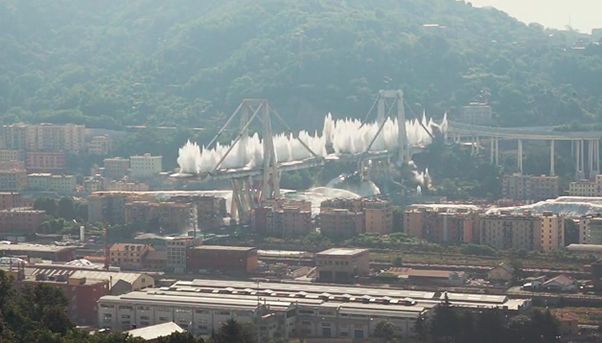
On June 25, the construction site siren sounded at 3:51 p.m., and cement mixers began to lay the concrete for the first foundation of the replacement for Genoa’s ill-fated Morandi Bridge. The Morandi Bridge had been dismantled section by section over the last few months as workers prepared for the final event.
On June 28, the sirens sounded again: at 9:37 a.m. Columns 10 and 11 of the Morandi were demolished.
The construction of bridge’s replacement is being carried out by the PERGENOVA company formed by Salini Impregilo and Fincantieri Infrastructure, following a design by architect Renzo Piano as a keel of a boat floating in the air.
«The first foundation of the new bridge is a milestone in a strategic project for Genoa and for the entire country», said Salini Impregilo Chief Executive Pietro Salini. «Not only does this project aim to bring a city closer to its surrounding area, but it also looks to the future of Italy by demonstrating that collaboration between the state and the country’s leading private companies can become a lever to unite and grow the nation».
This unity is more important than ever for Genoa, a city literally broken in two by the August 14 tragedy last year when the Morandi collapsed, causing the death of 43 people.
Mayor of Genoa and Commissioner overseeing the bridge reconstruction Marco Bucci said after the demolition June 28 that until the bridge gets its official name, it will be temporarily referred to during the phase of construction carried out by PERGENOVA as The “Pergenova Bridge.”
The new bridge: sustainability and technology
«Simple, thrifty, yet not commonplace. It will look like a ship moored in the valley; a clear and bright steel bridge. During the day it will reflect sunlight and absorb solar energy and at night it will return it. It will be a sober bridge, reflecting the character of the Genoese», said Renzo Piano in describing his design to rebuild the bridge over the Polcevera River, a 1,067-metre-long (3,500-feet) viaduct, with 19 reinforced concrete spans and 18 piers or columns.
An imposing infrastructure, but also modern and sustainable. The borders of the bridge will have a wind barrier that uses a photovoltaic energy supply system.

Air dehumidification devices will be deployed to avoid corrosion of the materials, while all of the equipment will be centrally managed from a nearby control centre. What is more, robots will carry out the structural inspection of the bridge and maintenance of the solar and acoustic panels, minimising the risk and need for human workers.
«The construction site has been up and running for months and if until yesterday the foundations were worked on and the plinths were reinforced, starting today the progress of construction will be clearly visible», said Nicola Meistro, head of PERGENOVA. «We have put together the best of our Italian know-how and all the experience gained in large infrastructure projects all over the world».
The new bridge’s impact on Genoa
Today Genoa is broken in two. Emergency measures to guarantee road links between the city and the region, as well as to ensure continued movement of people and goods to and from the port, were not enough to fill the great void left by the collapse of such a strategic infrastructure as the Morandi. The new bridge over the Polcevera will restore connections within the city, offering the surrounding area a more modern structure and therefore capable of encouraging an even greater flow of transport.
An essential project to improve mobility, but also to boost trade and employment. Hundreds of people are already working on the PERGENOVA site, and the number is destined to grow as the construction work progresses. Local employment levels will increase significantly thanks to another strategic transportation work for Genoa: the Terzo Valico dei Giovi, the railway line under construction for the high-speed train connecting Genoa with Turin and Milan, and from there with Northern Europe.
This project, carried out by the Cociv consortium led by Salini Impregilo will create a link between Genoa’s port system and the nearby regions of Piedmont, Lombardy and Veneto, which, between them, account for 50% of national goods transported.
This site could employ 2,500 people at peak times, and is destined to rise to up to 4,500 when all the construction sites are open.
The Terzo Valico and the new bridge over the Polcevera: these crucial projects will modernise the mobility of the city and the entire region, and increase the flow of goods and people at the port. Above all, they will give Genoa a chance to start again, a wounded city in search of a new life.

